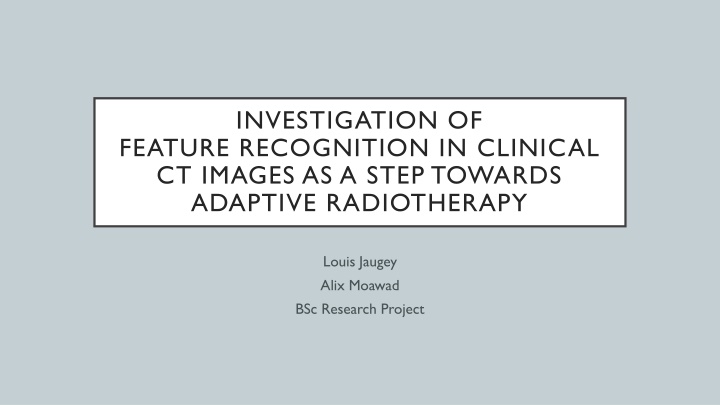
Feature Recognition in Clinical CT Images for Adaptive Radiotherapy
Explore the investigation of feature recognition in clinical CT images as a crucial step towards adaptive radiotherapy. The study includes phantom analysis, Gaussian filtering, directional derivatives method, Laplacian method, and edge Canny filter method for image processing and analysis.
Download Presentation

Please find below an Image/Link to download the presentation.
The content on the website is provided AS IS for your information and personal use only. It may not be sold, licensed, or shared on other websites without obtaining consent from the author. If you encounter any issues during the download, it is possible that the publisher has removed the file from their server.
You are allowed to download the files provided on this website for personal or commercial use, subject to the condition that they are used lawfully. All files are the property of their respective owners.
The content on the website is provided AS IS for your information and personal use only. It may not be sold, licensed, or shared on other websites without obtaining consent from the author.
E N D
Presentation Transcript
INVESTIGATION OF FEATURE RECOGNITION IN CLINICAL CT IMAGES AS A STEP TOWARDS ADAPTIVE RADIOTHERAPY Louis Jaugey Alix Moawad BSc Research Project
STUDY MATERIAL: PHANTOM 3D Phantom cut into 88 2D slices To simplify our study at first, only one slice chosen: slice 60 Our study becomes a 2D problem that could eventually turn back into a 3D problem
GAUSSIAN FILTER Smoothes the raw image and gives a blurry image by removing noise Applies a convolution product between the image and a 5 x 5 matrix whose inputs are given by a 2D Gaussian function On the right, result after applying the Gaussian Filter with a larger sigma than we actually used
PLAN OF THE PRESENTATION Directional derivatives Method Laplacian Method Edge Canny Filter Method
DIRECTIONAL DERIVATIVES METHOD Computation of the Horizontal and Vertical derivatives using centred finite difference The horizontal derivatives (on the left) emphasize vertical edges and vice versa for vertical derivatives The next step is to detect peaks on both images
DIRECTIONAL DERIVATIVES METHOD Search for the peaks with two different minimal peak intensity Connect the pixels of low intensity with the high intensity ones
LAPLACIAN METHOD Laplacian computed at each point using central finite differences Some holes are not visible anymore
LAPLACIAN METHOD Search for zero crossings of the Laplacian operator Threshold method by percentage: less than 15% of the brightest contours displayed
EDGE CANNY FILTER: FILTER APPLICATION Computation of the intensity gradient in each pixel Pixel separation in two categories: high and low gradient intensity Connect the pixels having a low gradient intensity with the ones having a high intensity
EDGE CANNY FILTER: BORDER SEPARATION Attribution of a number specific to a border, using a recursive algorithm This number is random for better visualization Filling Regions with the same colour as the border
EDGE CANNY FILTER: BORDER SEPARATION Attribution of a number specific to a border, using a recursive algorithm This number is random for better visualization Filling Regions with the same colour as the border
FURTHER WORK AND CONCLUSION Phantoms have very well-defined regions. Edge detection on real patients' images is a much harder problem. Application of these methods on 3D CT-scans. Latest algorithms used in image treatment rely on Machine Learning techniques. This will be the subject of interest for the second term.
